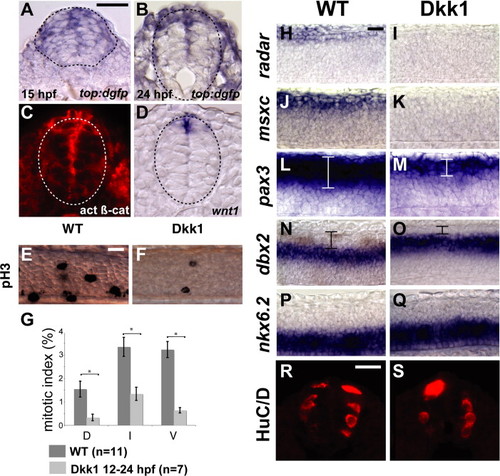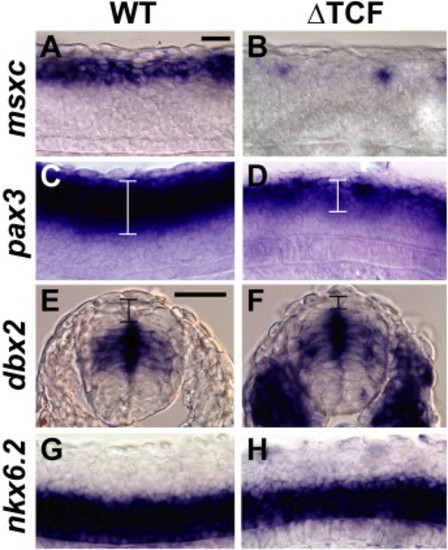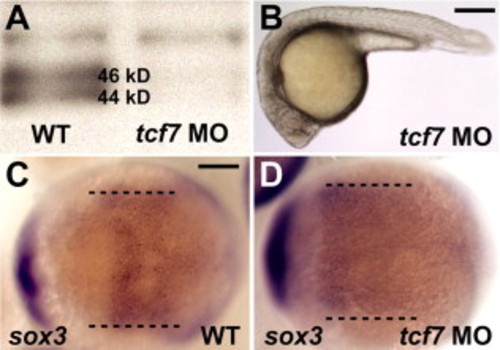- Title
-
Proliferation and patterning are mediated independently in the dorsal spinal cord downstream of canonical Wnt signaling
- Authors
- Bonner, J., Gribble, S.L., Veien, E.S., Nikolaus, O.B., Weidinger, G., and Dorsky, R.I.
- Source
- Full text @ Dev. Biol.
|
Canonical Wnt signaling regulates proliferation and patterning in the developing spinal cord. (A) Expression of top:dgfp, a β-catenin-dependent reporter, is widespread in the neural keel (dotted line) at 15 hpf, with a dorsal bias. (B) Expression of top:dgfp is restricted to the dorsal spinal cord at 24 hpf. (C) Immunofluorescence of unphosphorylated β-catenin is localized to the dorsal spinal cord at 24 hpf. (D) Expression of wnt1 is found in the roof plate of the spinal cord at 24 hpf. (E, F) Immunostaining for phospho-histone H3 is reduced at 24 hpf following Dkk1 overexpression at 12 hpf. (G) The mitotic index is reduced in dorsal, intermediate and ventral domains following Dkk1 overexpression. *p < 0.05 by T-test; error bars indicate ± SEM. (H, I) Expression of radar and (J, K) msxc is eliminated following Dkk1 overexpression. (L, M) Expression of pax3 is reduced in Dkk1-expressing embryos. (N, O) Expression of dbx2 shifts into the dorsal domain in Dkk1-expressing embryos. (P, Q) Expression of nkx6.2 is unaffected in Dkk1-expressing embryos. (R, S) HuC/D immunostaining is unaffected in Dkk1-expressing embryos. (A–D, R, S) show 12 μm cross-sections, and (E, F, H–Q) show lateral mounts. Scale bars = 10 μm. |
|
Reduction of cell proliferation does not cause spinal cord patterning defects. (A, B) Anti-phospho histone H3 staining reveals a decrease in proliferative cells in the HUA-treated spinal cord. (C, D) Expression of pax3 is unaffected in embryos treated with HUA for 12 h. (E, F) The dbx2 expression domain is unchanged in HUA embryos although an overall decrease in signal was observed. Expression in the dorsal epidermis is non-specific. (G, H) Expression of nxk6.2 is unaffected in HUA-treated embryos. Lateral mounts are shown. Scale bar = 10 μm. EXPRESSION / LABELING:
|
|
Tcf7 is required for dorsal progenitor patterning. (A) At 15 hpf, tcf7 is expressed widely throughout the neural keel (dotted line), with a dorsal bias. (B) At 24 hpf tcf7 is expressed in the dorsal spinal cord as well as the median fin fold. (C) There is no significant decrease in the mitotic index of the dorsal and intermediate domains in tcf7 morphants, but mitosis in the ventral domain is significantly reduced. *p < 0.05 by T-test, error bars indicate ± SEM. (D, E) Expression of wnt1 and (F, G) radar mRNA is unaffected in tcf7 morphants. (H, I) Expression of msxc and (J, K) pax3 is reduced in tcf7 morphants. (L, M) Expression of dbx2 shifts into the dorsal domain in tcf7 morphants. (N, O) Ventral expression of nkx6.2 is unaffected in tcf7 morphants. (A, B) 12 μm cross-sections are shown. (D–O) Lateral mounts are shown. Scale bars = 10 μm. EXPRESSION / LABELING:
PHENOTYPE:
|
|
Tcf3 is required for proliferation but not for dorsal progenitor patterning. (A–D) Both tcf3a (A, B) and tcf3b (C, D) are expressed at higher levels in tcf7 morphants. (E) The mitotic index in dorsal, intermediate and ventral domains is significantly reduced in tcf3a/tcf3b double morphants. *p < 0.05 by T-test, error bars indicate ± SEM. (F, G) Expression of msxc and (H, I) pax3 is unaffected in tcf3a/tcf3b double morphants. (J, K) Expression of dbx2 is eliminated in tcf3a/tcf3b double morphants, but the intermediate progenitor domain is not shifted dorsally as indicated by iro3 expression (L, M). (A–D) 12 μm cross-sections are shown. (F–M) Lateral mounts are shown. Scale bars = 10 μm. |
|
Transcriptional activation by Lef/Tcf factors mediates progenitor patterning in the spinal cord. (A, B) Expression of msxc and (C, D) pax3 is reduced in ΔTcf-expressing embryos. (E, F) Expression of dbx2 shifts into the dorsal domain of the spinal cord in ΔTcf-expressing embryos, and is ectopically present in the somites. (G, H) Expression of nkx6.2 is unaffected in ΔTcf-expressing embryos. (A–D, G, H) Lateral mounts are shown. (E, F) 12 μm cross-sections are shown. Scale bars = 10 μm. EXPRESSION / LABELING:
|
|
Effects of Dkk1 overexpression are temporally separable. (A) The mitotic index at 24 hpf is unaffected in all domains of the spinal cord following Dkk1 induction at 18 hpf. Error bars indicate ± S.E.M. (B–C) radar expression is unaffected following late Dkk1 induction. (D–E) Expression of msxc and (F–G) pax3 expression are reduced in dorsal progenitors, and (H–I) expression of dbx2 shifts dorsally when Dkk1 expression is induced at 18 hpf. (B–I) Lateral mounts are shown. Scale bars = 10 μm. EXPRESSION / LABELING:
|
|
A tcf7 morpholino effectively blocks protein translation but does not affect early embryogenesis. (A) Western blot analysis of Tcf7 protein levels indicate reduction of 44 kDa and 46 kDa Tcf7 isoforms in tcf7 morphants. (B) Overall morphology of 24 hpf tcf7 morphants is unaffected. (C–D) Expression of sox3, a neural plate marker, is unaffected at bud stage in tcf7 morphants. Dashed lines outline the neural plate. Scale bars: B = 200 μm; C–D = 100 μm. |

Unillustrated author statements PHENOTYPE:
|
Reprinted from Developmental Biology, 313(1), Bonner, J., Gribble, S.L., Veien, E.S., Nikolaus, O.B., Weidinger, G., and Dorsky, R.I., Proliferation and patterning are mediated independently in the dorsal spinal cord downstream of canonical Wnt signaling, 398-407, Copyright (2008) with permission from Elsevier. Full text @ Dev. Biol.







